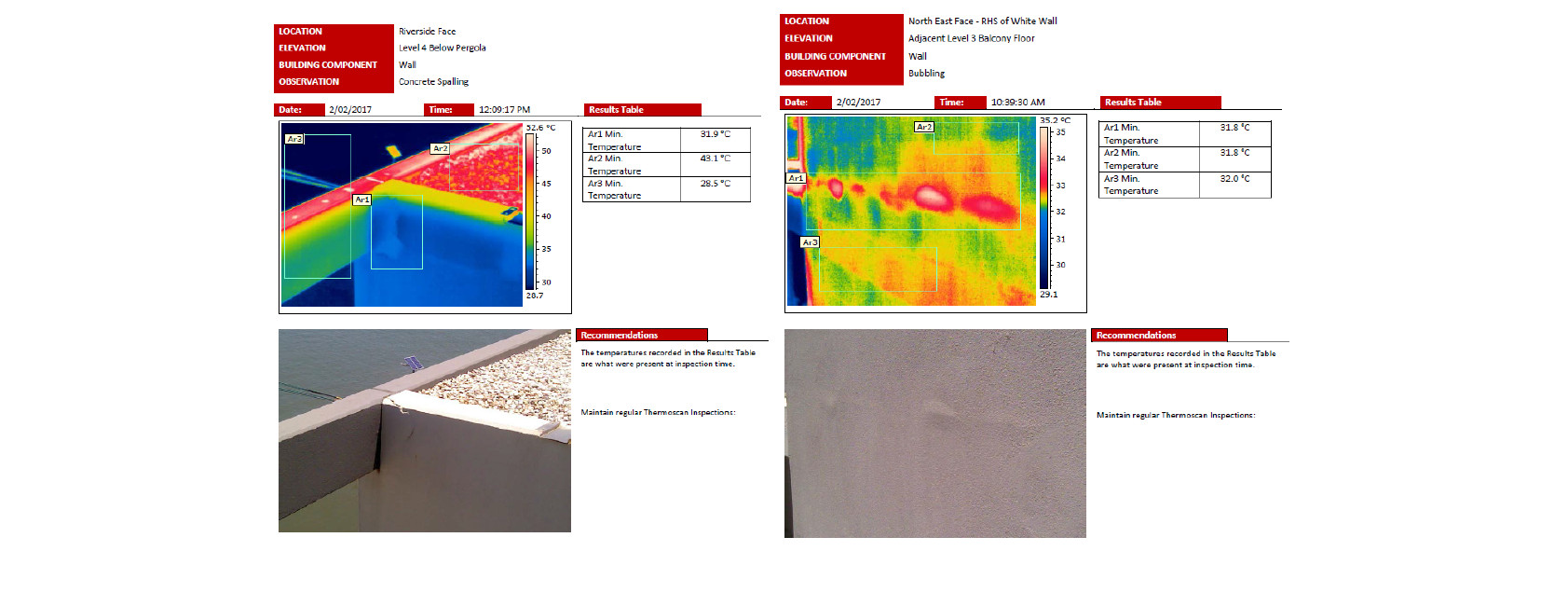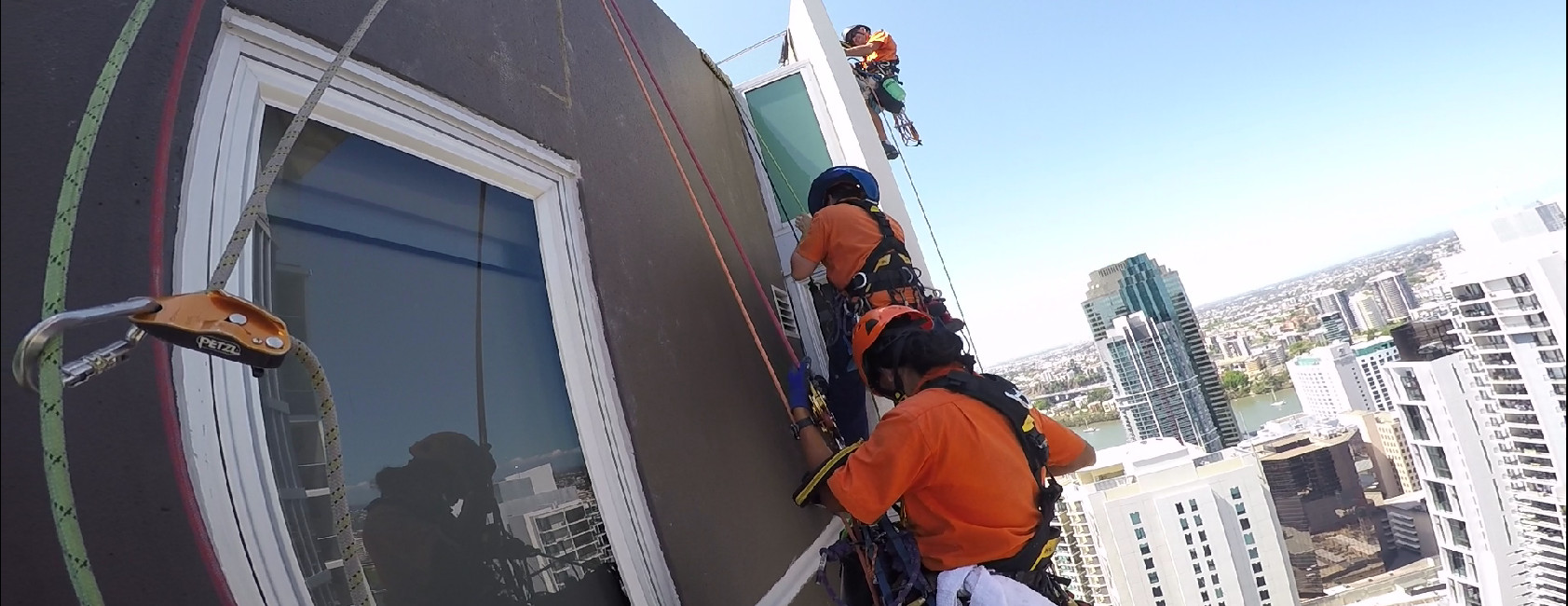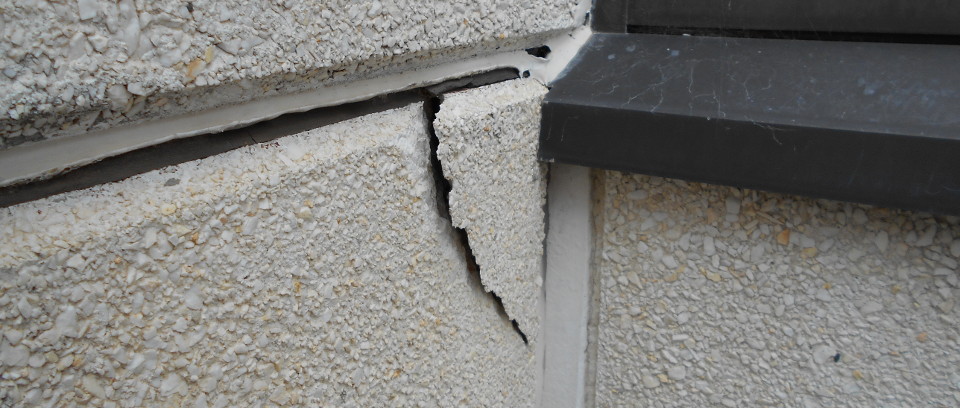Facade Inspection via Rope Access
Sitting 10 stories high along the Brisbane river, a residential complex was nearing the end of its 10 year warranty period. The facade had been subjected to salt water winds for the past decade which had started to affect the alkalinity of the facades concrete. Bells was entrusted to inspect and report on the fitness of the facade to help inform the body corporate of their situation.

Building Height
Project Period
Facade Surface Inspected
Facade Waterproofing and Leak Repair
With construction ending in 2006, the 42 story Brisbane residential high-rise was coming to the end of its warranty period, building management had noticed an increase in water ingress into a large number of the buildings units. Tasked with inspecting the buildings facade Bells discovered the buildings waterproofing system had started to fail substantially. All vertical seals had deteriorated considerably and were failing, along with missing sealant around windows, flashing and vents causing water to penetrate the facade.

Building Height
Project Period
Sealant Replaced
Facade Concrete Repair and Waterproofing
Built in 1977, the facade of the 29 story Brisbane CBD high-rise had deteriorated heavily around window frames, slab edges, and decorative mounting points. Failure of the original sealant system had allowed water to penetrate and accelerate the deterioration of the underlying reinforcement. The concrete spalling (concrete cancer) created from the expanding corroding reinforcement within the concrete facade had created numerous potential hazards for passers by below.

Building Height
Project Period
Sealant Replaced
As long term operators of high access services, Bells remain concerned about safety in our industry sector.
We have real concerns about the lack of competency and the application of inappropriate safety standards by some companies and individuals performing Rope Access work. We would like to stress that where appropriate Codes of Practice and operating Standards are applied Rope Access is a very safe and effective means of work.
The issues we wish to raise include:
- The lack of Industry guidance, certification of operators and regulation for Rope Access activity;
- The lack of rescue planning and training regulatory requirements for work using Industrial Rope Access;
- and The definition of high risk activity in the work place.
The current Safety Landscape.
In Queensland, NSW and Victoria there have been a number of serious incidents involving Rope Access technicians in recent times. Whilst, there is an obligation on a Rope Access technician or company to report a safety breach or incident, many injuries and accidents often go unreported.
Currently in Queensland a business or individual can undertake high rise maintenance using Rope Access techniques with only minimal competency, limited training, and no supervision or certification. Rope Access activity is dealt with under Australian Standard 4488 Industrial Rope Access Systems. However, this standard primarily deals with the application of and use of Rope Access equipment and techniques.
It does not provide any prescription as to how Rope Access activities should be planned, managed, assessed or certified for safety purposes. Equally the relevant state legislation and regulations does not deal with this important consideration for Rope Access work. In fact Rope Access work is not a prescribed “high risk “activity under Section 81 Schedule 3 Qld QHS Regulations 2011.
Licensing and Regulation
A Rope Access technician can complete a four day skills competency course before commencing work. However, in many instances this is not the case and the Rope Access operator is not obliged to provide an up to date certificate of competency. This in itself is inconsistent with the intent of Section 85 of the Qld WHS Regulations 2011.
In many respects in Queensland Rope Access, like other States, is a largely unregulated and unsupervised work activity.
The only relevant Codes of Practice that have any depth, accreditation and independent verification are the Industrial Rope Access Trade Association’s (IRATA) International Code of Practice and the ISO 22846-2 Rope Access Code of Practice.
Facts that bear consideration if the Rope Access industry is to be made a safer and more accountable work activity are:
- The levels of training and certification of Rope Access operators In Queensland are inconsistent and uneven.
- Many Rope Access operators are “qualified” by unaccredited training operators. (In the case of IRATA trained Rope Access operators this is not the case, as the IRATA training company is subject to a regular rigorous external validation and audit.)
- Rope Access operators do not have any obligation to maintain currency of their Certificate of Competency. (There is no current legislation that requires a Rope Access technician to undertake refresher or recertification training unless he is an IRATA technician working for an IRATA certified company.)
- Rope Access is not regarded as a high risk work activity under Queensland Acts or regulations.
What our Industry needs.
As Rope Access is an unregulated work activity, there is a lack of knowledge by Persons Conducting a Business Undertaking (PCBU) as to what codes of practice; administrative or regulatory matters are relevant to rope access work.
We advocate the consideration of:
- Developing a regulatory framework or Industry Guidelines for Rope Access work activity;
- Implementation of a mandatory Rope Access Industry Code of Practice which is subject to audit or accreditation by competent third party
- The inclusion of Rope Access as a high risk work activity and subject to the licence requirements under the Work Health and Safety Act 2011;
- And Implementation of a requirement in Queensland for Rope Access operators to renew their certificate of competency every three years.
- Mandatory Emergency/Rescue Planning for Rope Access in Queensland each day.
Hundreds of workers are conducting Rope Access work activities without any formal or regular training in emergency or rescue techniques. This applies only to operators that they have not undertaken an IRATA or ARAA training course as part of their original certification. Apart from those certified under those training schemes, there is no requirement for a Rope Access operator to undertake regular refresher training in rescue procedures; this needs to change.
“We are not saying that Rope Access is an unsafe work practice, far from it.”
Furthermore there is no obligation to record any training if it is conducted or to demonstrate that it is vocationally relevant.
We advocate the consideration of mandatory rescue training and rescue planning for operators of Rope Access Systems. High Risk Work Activity in Queensland Currently, there is a dearth of guidance or regulation for Rope Access operators in the state.
In comparison to other high risk work activities we believe that Rope Access is just as dangerous if not more so than some other activities covered by the WHS 2011 Regulation 81.
Where operators are appropriately trained and their work practices subject to oversight and review it is an extraordinarily effective means of work in inaccessible places. As support for the last statement, we attach a copy of the recent IRATA Work Safety Report 2016 that demonstrates that Rope Access is a very safe activity when managed and operated correctly.

